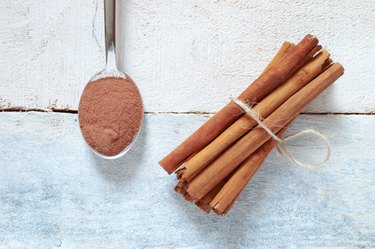
All types of cinnamon belong to the genus Cinnamomum, so there really isn't a "fake" cinnamon. But true cinnamon comes from one specific species -- Cinnamomum verum -- which is native to Ceylon. Other types of cinnamon come from several different cinnamomum trees. They're collectively referred to as cassia cinnamon. While they all contain the same active ingredient, true cinnamon has the benefit of being low in coumarin.
Cinnamon Comparison
Video of the Day
Compared to cassia cinnamon, true cinnamon is lighter in color, tastes slightly sweeter and has a more fragrant aroma. True cinnamon also costs more. Due to the price difference, most cinnamon in your local grocery store consists of cassia cinnamon. All types of cinnamon contain the active ingredient cinnamaldehyde, which accounts for 65 percent to 80 percent of the essential oil, according to Drugs.com. Because true cinnamon and cassia cinnamon share this active ingredient, they may have similar benefits. Research to date has focused on cassia cinnamon, however.
Video of the Day
Coumarin Content
Coumarin occurs naturally in a few plants, including cinnamon, but it's also synthetically produced because it helps prevent blood clots. If it's consumed in large doses for an extended period of time, coumarin may cause or worsen liver disease. True cinnamon contains barely a trace of coumarin, while other types of cinnamon may have 18 to 400 times more, according to the May 2013 issue of the "Journal of Agricultural and Food Chemistry." Coumarin in cinnamon is not currently regulated in the United States. The German Federal Institute for Risk Assessment, however, reports that a person weighing 132 pounds would consume the maximum intake of coumarin recommended by the European Union by eating 3/4 to 1 teaspoon of cassia cinnamon daily.
Lower Blood Sugar
Cinnamon lowered blood sugar in lab rats, with cassia outperforming true cinnamon, according to the March 2005 issue of "Phytotherapy Research." A review published in September 2012 in the "Cochrane Database of Systematic Reviews" concluded that the evidence was insufficient to support cinnamon as a treatment for diabetes. After several more studies were performed, another review reported that cassia cinnamon lowered fasting blood sugar. Using the information in real patient care, however, is difficult because the doses used and the duration of treatment were different in each study, according to the September 2013 issue of "Annals of Family Medicine."
Supplement Doses and Warnings
The typical dose for cinnamon supplements is 1 to 4 grams daily, according to New York University Langone Medical Center. For the more potent cinnamon oil, a typical dose is about 0.05 to 0.2 gram daily. No adverse reactions have been reported at dosages of up to 6 grams daily, reports Drugs.com. Larger amounts of cinnamon powder and oil may increase your breathing and heart rate. When cinnamon oil is used topically, it may cause flushing, a burning sensation or an allergic skin reaction. If you're pregnant, take prescription medications or have liver disease or diabetes, talk to your physician before taking cinnamon supplements.
- Cinnamon Vogue: Types of Cinnamon
- Drugs.com: Cinnamon
- PubChem: Coumarin
- MedlinePlus: Cassia Cinnamon
- Journal of Agricultural and Food Chemistry: Cassia Cinnamon as a Source of Coumarin in Cinnamon-Flavored Food and Food Supplements in the United States
- New York University Langone Medical Center: Cinnamon
- Phytotherapy Research: Antidiabetic Effect of Cinnamomum Cassia and Cinnamomum Zeylanicum in Vivo and in Vitro
- Cochrane Database of Systematic Reviews: Cinnamon for Diabetes Mellitus
- Annals of Family Medicine: Cinnamon Use in Type 2 Diabetes: An Updated Systematic Review and Meta-Analysis
- BfR: Federal Institute for Risk Assessment: New Insights Into Coumarin Contained in Cinnamon
- USDA National Nutrient Database: Spices, Cinnamon, Ground